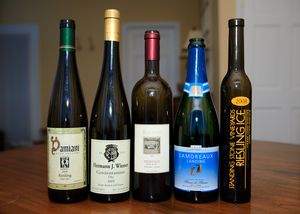By Evan Dawson, Finger Lakes Editor
Photo by Morgan Dawson Photography
 Imagine for a moment that you're a contestant on one of the myriad reality TV cooking shows. Chopped, Hell's Kitchen, whatever you like. In this episode, you're going to be given a mystery item around which you must center your dish. When the mystery item is revealed, you will have 20 minutes to create something delicious, no matter how challenging this item is. If they can create an edible dessert out of durian, you can pull something off. Are you ready?
Imagine for a moment that you're a contestant on one of the myriad reality TV cooking shows. Chopped, Hell's Kitchen, whatever you like. In this episode, you're going to be given a mystery item around which you must center your dish. When the mystery item is revealed, you will have 20 minutes to create something delicious, no matter how challenging this item is. If they can create an edible dessert out of durian, you can pull something off. Are you ready?
Glass shards. You'll have to cook with glass shards.
You are probably laughing. Finger Lakes winemakers are nodding. In 2009, they were the reality TV contestant, and mother nature gave them glass shards.
We're talking about acid here, and before anyone gets the wrong idea, it should be noted that acid is essential. This is not some rationalization or excuse. Fat wines don't even have good personalities. They're just fat.
The Finger Lakes provides a consistent and natural source of acid. That's why its sparkling wines sparkle and aromatic white wines shine. But in 2009, the cool growing season resulted in some serious electricity for most varieties. Winemakers, presented with a potentially unpalatable set of glass shards, got busy doing the things they found necessary to create quality wines.
Some de-acidified. Who can blame them? The absolutists might scream, but working with nature means occasionally apologizing for her gaffes. She is not perfect.
But other winemakers chose a different path, and the Finger Lakes Riesling of the Year is a fine example.
Damiani Wine Cellars winemaker Lou Damiani had never made a riesling with 40 grams of residual sugar. He probably never conceived it was possible. But instead of adhering to some dogma, he tried to listen to the vintage. And it told him that if he wanted balance, he had to tame the acid.
In other words, he was handed glass shards, and it was time to coat the glass with a rich and pleasing sweetness.
To say Lou's efforts paid off is an understatement. The Damiani 2009 Riesling is a stunner, crackling with natural acidity and still rich and juicy. You can read all about Lou's decisions in this piece we recently published.
"That's five pounds of riesling in a four-pound bag," was one of the comments during the tasting. In a sense, it's true; there's so much going on that it's not a cinch to hold together in the long term. But the editors are betting that it will. We expect this wine will take on a fascinating aging track, staying fresh and vibrant for quite some time before eventually settling into an extended mature phase that the best off-dry rieslings enjoy.
Riesling lovers should delight in pouring this for friends, who will be hard-pressed to guess this wine has more than 20 grams of residual sugar. And there's still a good amount to be found. Damiani has 100 cases remaining, selling for $16 per bottle.
Our Finger Lakes Sparkling Wine of the Year comes from another recent vintage that featured lots of acidity. The Lamoreaux Landing 2006 Blanc de Blanc is precise and crisp. Utterly clean and beautifully made, it's available for $25 a bottle.
The Finger Lakes non-Riesling White Wine of the Year is the Hermann J. Wiemer 2009 Gewurztraminer, another marvelous white from this vintage. Unlike so many gewurztraminers from around the world, this wine shows not even a whisper of obtrusive heat. Nor does it fall into the trap that makes so many gewurztraminers polarizing; this is a variety that is prone to over-doing one particular feature of the grape. It can be all spice or all women's perfume or all lychee. This wine is balanced on a beam that spreads out and coats the mouth on impact with flowers and spices and tropical fruit. It's available now for $23 a bottle.
"Classic, impressive, and the measure of what gewurztraminer can be," I said when I tasted it blind in our tasting. I didn't know it was a 2009 until it was unbagged.
And that might be the most important result when it comes to the wines of 2009. Finger Lakes pinots from the top producers are already impressing, and the rieslings are showing potential to be truly special. Turns out those glass shards had the potential to smooth out and become something beautiful. Even many dry riesling bottlings are balanced, energetic, vivacious.
And to say that some wines will not only age gracefully, but improve with time in the bottle… Well, you don't need a slickly produced reality TV show to explain what that means.
